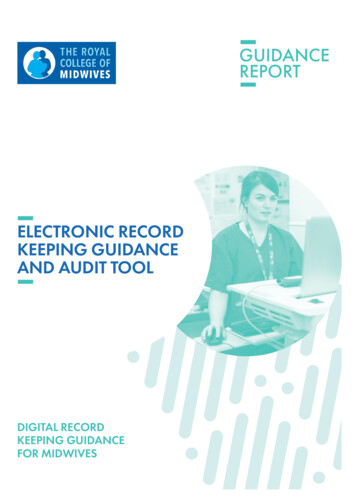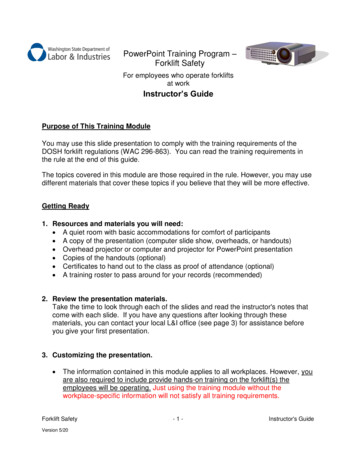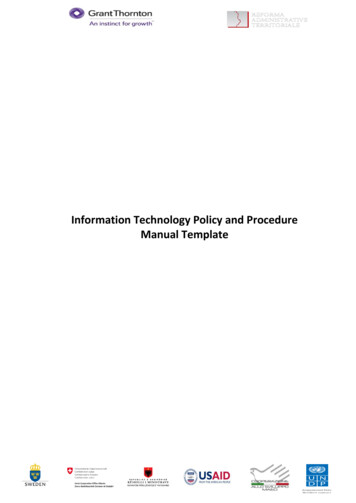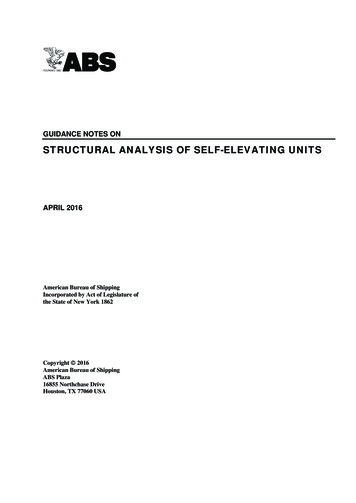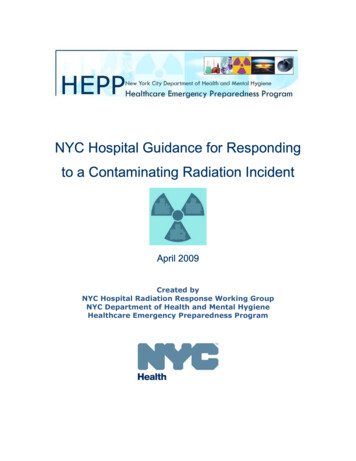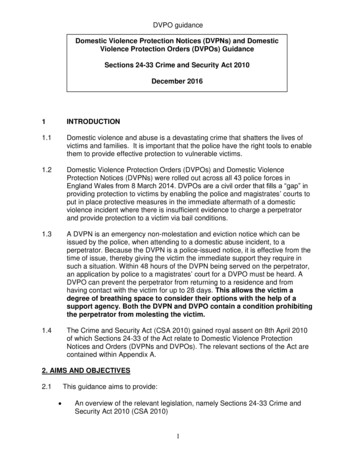
Transcription
DVPO guidanceDomestic Violence Protection Notices (DVPNs) and DomesticViolence Protection Orders (DVPOs) GuidanceSections 24-33 Crime and Security Act 2010December 20161INTRODUCTION1.1Domestic violence and abuse is a devastating crime that shatters the lives ofvictims and families. It is important that the police have the right tools to enablethem to provide effective protection to vulnerable victims.1.2Domestic Violence Protection Orders (DVPOs) and Domestic ViolenceProtection Notices (DVPNs) were rolled out across all 43 police forces inEngland Wales from 8 March 2014. DVPOs are a civil order that fills a “gap” inproviding protection to victims by enabling the police and magistrates’ courts toput in place protective measures in the immediate aftermath of a domesticviolence incident where there is insufficient evidence to charge a perpetratorand provide protection to a victim via bail conditions.1.3A DVPN is an emergency non-molestation and eviction notice which can beissued by the police, when attending to a domestic abuse incident, to aperpetrator. Because the DVPN is a police-issued notice, it is effective from thetime of issue, thereby giving the victim the immediate support they require insuch a situation. Within 48 hours of the DVPN being served on the perpetrator,an application by police to a magistrates’ court for a DVPO must be heard. ADVPO can prevent the perpetrator from returning to a residence and fromhaving contact with the victim for up to 28 days. This allows the victim adegree of breathing space to consider their options with the help of asupport agency. Both the DVPN and DVPO contain a condition prohibitingthe perpetrator from molesting the victim.1.4The Crime and Security Act (CSA 2010) gained royal assent on 8th April 2010of which Sections 24-33 of the Act relate to Domestic Violence ProtectionNotices and Orders (DVPNs and DVPOs). The relevant sections of the Act arecontained within Appendix A.2. AIMS AND OBJECTIVES2.1This guidance aims to provide: An overview of the relevant legislation, namely Sections 24-33 Crime andSecurity Act 2010 (CSA 2010)1
DVPO guidance Interpretation of this legislation into a national process (Annex B details aprocess map) Cross-references to existing processes and guidance documents;i)Authorised Professional Practice for Domestic Abuseii)Domestic Abuse, Stalking and Harassment and HonourBased Violence Risk Assessment (DASH)iii)Multi-Agency Risk Assessment Conferences (MARACs)2.2A Domestic Violence Protection Notice and subsequent Order are aimed atperpetrators who present an on-going risk of violence to the victim with theobjective of securing a co-ordinated approach across agencies for theprotection of victims and the management of perpetrators.2.3The DVPN / DVPO process builds on existing procedures and bridges thecurrent protective gap, providing immediate emergency protection for the victimand allowing them protected space to explore the options available to them andmake informed decisions regarding their safety.2.4The DVPN / DVPO process does not aim to replace the criminal justice systemin respect of charge and bail of a perpetrator. A DVPN will be issued incircumstances where no other enforceable restrictions can be placed upon theperpetrator. It is important that there is no conflict between any bail conditionsand the terms of a DVPN.2.5Officers should always give consideration to identification of and prosecution forsubstantive criminal offences, If CPS advice is to charge for a domestic relatedoffence then a DVPN may not be necessary or proportionate where there is aremand in custody (RIC) or when strict bail conditions are in place.3. MULTI-AGENCY ENGAGEMENT3.1Although the power to issue a DVPN and subsequent application for a DVPOlies with the police and ultimately the criminal justice service, the success of anysuch process will be reliant on the partnership work with other agencies andorganisations including those that contribute to Multi-Agency Risk AssessmentConferences1 (MARACs) and service providers for Independent DomesticViolence Advocates2 (IDVAs) or other, similar services.1MARACs are voluntary meetings where information is shared on the highest risk cases betweenrepresentatives from local police, health, child protection, housing, IDVAs and other specialists from thevoluntary and specialist sectors. A coordinated safety plan for each victim is then created.2Independent Domestic Violence Advocates (IDVAs) are independent professional advisors that workwith victims from the point of crisis to assess the level of risk, discuss the range of suitable options and2
DVPO guidance3.2Engagement with the victim and the agencies referred to above at the earliestopportunity, is crucial to the success of the DVPN/ DVPO process.3.3 Summary3.3.1It is important to note that a DVPN (and subsequent DVPO) should be issuedwhen it is necessary to protect a person from violence/threat of violence fromthe Perpetrator and is seen as an additional mechanism available to policeforces alongside existing processes / procedures designed to provideemergency protection to victims of domestic violence.3.3.2It is essential that throughout the process, all officers involved ensure thatsubstantive criminal offences are thoroughly investigated and actively pursued.3.3.3It is envisaged that a DVPN will be issued in incidents that fit or are likely to fulfilthe following criteria:CriteriaAlleged perpetrator is 18 oroverViolence used orthreatened on this occasiontowards the victim and/oran associated personAlleged perpetrator is to bereleased from custodywithout any conditions (i.e.NFA, Caution or bailwithout conditions)DVPN necessary to protectthe victim and/or associatedperson from violence orthreat of violence by thealleged perpetratorRequiredExplanationYYThis outcome willstrengthen the necessityand justification for theissuing of a DVPN.Y4. DEFINITIONS4.1Victim (V) The person for whom the Notice or Order is aimed at providingprotection. In this guidance the Victim will be referred to as ‘V’4.2Alleged perpetrator (P) must be aged 18 years or overdevelop coordinated safety plans. In some areas different titles are used for organisations and individualswho provide similar support.3
DVPO guidance4.3Authorising Officer (AO) a member of a police force not below the rank ofSuperintendent.4.4Domestic Violence Protection Notice (DVPN) – A DVPN is the initial notice ofimmediate emergency protection that is issued by a police force.1)The DVPN will include:(a)the grounds on which it has been issued,(b)that a constable may arrest P without warrant if the constable hasreasonable grounds for believing that P is in breach of the DVPN,(c)that an application for a domestic violence protection order undersection 27 will be heard within 48 hours of the time of service of theDVPN and a notice of the hearing will be given to P, The Notice ofthe Hearing will act as the summons for this purpose and must begiven to P under section 27(5).(d)that the DVPN continues in effect until that application has beendetermined (or 48 hours has expired), and(e)the provisions that a magistrates’ court may include in a domesticviolence protection order.2)A DVPN must be in writing and must be served on P personally by aconstable.3)On serving P with a DVPN, the constable must ask P for an address forthe purposes of being given the notice of the hearing of the application forthe domestic violence protection order.4.4.1 Notice of the HearingThe Notice of the Hearing acts as a summons for the purposes of theapplication for the DVPO to be heard at Magistrates Court within 48 hours of theDVPN being served (excluding Sundays, Bank Holidays, Christmas and GoodFriday). A requirement of section 27(5) Crime and Security Act 2010 is that theNotice of the Hearing must be given to P in all cases and is separate to theDVPN.4.5Domestic Violence Protection Order (DVPO) – a DVPO is an order made bya magistrates’ court after a DVPN has been issued. The protective conditionsavailable to a magistrates’ court are the same as those available to the AO. ADVPO may be in force for between 14-28 days, beginning on the date it is madeby the magistrates’ court.4
DVPO guidance4.6Associated Person (AP) – an associated person means a person who isassociated with the alleged perpetrator within the meaning of section 62 of theFamily Law Act 1996.In summary this includes: they are married or have been married; they are cohabitants or former cohabitants; they live or have lived in the same household, otherwise than merely byreason of one of them being the other’s employee, tenant, lodger orboarder; they are relatives; they have agreed to marry one another (whether or not that agreementhas been terminated); in relation to any child, they are either a parent or have parentalresponsibility for a child.This will also include civil partners, people who have entered into a civilpartnership agreement and people who have or have had an intimate personalrelationship with each other which is or was of a significant duration.4.7Constable –A complaint can be made by the police constable in person, by asolicitor employed by the police, by a barrister/legal advisor instructed by thepolice or by ‘another person authorised to make the complaint’.4.8Time periods - In calculating when the period of 24 hours and 48 hours ends,Christmas Day, Good Friday, any Sunday and any day which is a bank holidayin England and Wales are to be disregarded.4.9‘Made by Complaint’ – In addition to the DVPN, detailing the prohibitionsissued by the Authorising Officer, P will be served with a Notice of the Hearingof a DVPO application under section 27(5) and this will be treated as asummons. The complaint is the application for the DVPO which must be madeto a magistrates’ court within 48 hours of the service of the DVPN.4.10Breach of a DVPN – a constable may arrest P without warrant if the constablehas reasonable grounds for believing that P is in breach of the DVPN. Section29(1) provides a power of arrest and a duty to remand in custody and bring Pbefore a magistrates’ court within 24 hours from the time of arrest.4.11Breach of a DVPO - a constable may arrest P without warrant if the constablehas reasonable grounds for believing that P is in breach of the DVPO. Section29(1) contains a duty to remand P in custody and bring P before a magistrates’court within 24 hours from the time of arrest. The breach of the DVPO will be acivil contempt of court, treated as a breach of a civil order under section 63 ofthe Magistrates’ Court Act 1980 (MCA). Section 57A of the MCA allows for thetransfer of civil proceedings to another magistrates’ court.5
DVPO guidance5. THE DVPN / DVPO PROCESSAn overview of the entire DVPN / DVPO process is summarised in Appendix B:DVPN / DVPO Process Map.5.1 Stage 1 – Application to Authorising Officer (AO)5.1.1A DVPN can only be issued by a police officer of the rank of Superintendant orabove. Early consideration must be given to the gathering of evidence and theneed to make contact with a Superintendant who may not be readily available.This will be particularly apparent outside of normal office hours where the ‘oncall’ Superintendent will have to be contacted, utilising existing force protocols.5.1.2It is also important to recognise that there is no power contained within sections24-33 of the CSA 2010 to detain a person in custody purely for theconsideration and service of a DVPN. If a DVPN is to be issued whilst P is incustody for other reasons, the DVPN must be issued before any existingpowers to detain P have expired. However, there is no requirement for P to bein custody for a DVPN to be served.5.1.3A DVPN / DVPO does not require the consent of the victim and therefore allother evidence / information available should be passed to the Superintendentand also the relevant magistrates’ court. It may be necessary and proportionateto issue a DVPN even though a victim does not wish it because there may besuspicion of the presence of coercive and controlling behaviour affecting thedecision-making of the victim or it may simply be necessary to protect thevictim. Officers should consider carefully whether the issue of a DVPN isnecessary and proportionate to protect the victim.5.1.4In all domestic abuse cases officers/staff should consider the incident as awhole including previous calls to the address, the presence and welfare ofchildren, other witness accounts and any other available intelligence held byother agencies. It is imperative to the success of the DVPN / DVPO processthat this investigation is conducted at the earliest opportunity as it will form partof the information given to the AO.5.1.5In the context of this guidance, a child is any person under the age of 18 years.The police have a duty to have regard to the need to safeguard and promotethe welfare of children when exercising their functions; in all investigations theprinciple that the welfare of the child is paramount should be observed.5.1.4The presence of children is particularly important as the AO must consider thewelfare of any person under the age of 18 whose interests the officer considersrelevant to the issuing of the DVPN (whether or not that person is an AP).6
DVPO guidance5.1.5Nothing in this guidance or due to the implementation should alter the existingarrangements for risk identification (DASH). A DASH risk assessment, orequivalent, should form part of the information that is provided to thesuperintendent upon seeking approval for the issue of a DVPN.5.1.6Nothing regarding the implementation should change the process of referrals toMARAC (cross reference 6.2.3 GIDA) and subsequent safety planning (crossreference 6.2.4 GIDA). Where a DVPN/DVPO is issued and the case has beenrisk assessed as being HIGH the case is to be taken to MARAC.5.1.7Police forces may wish to consider the use of a ‘gate-keeper’ to determine theappropriateness of the request prior to a Superintendent being contacted, suchas the custody sergeant or duty inspector. Consultation and authority must be sought from an AuthorisingOfficer of the rank of Superintendent or above, at an early stage.5.2 Stage 2 - Authorisation of DVPN5.2.1Section 24(1)-(2) of the CSA 2010 provides the power to issue a DVPN.The AO may issue a DVPN to P if they have reasonable grounds forbelieving that: P has been violent towards, or has threatened violence towards an APAnd 5.2.2The issue of the DVPN is necessary to protect that person from violenceor a threat of violence by P.With regards to necessity to prevent further violence / threat of violence,consideration should be given to: What the DVPN will seek to achieve and why this cannot be obtained byany other or less disruptive means, e.g. bail conditions not applicable or Phas accepted a formal police caution; Whether the risk of harm is too great to allow P to return to the addressand therefore the sole use of a suitable risk management plan is notadequate; The only option to reduce risk of further violence or threat of violence is toremove P from the address and to continue to deny access to P by issuinga DVPN.7
DVPO guidance5.2.3Section 24(3)-(5) of the CSA 2010 outlines the areas that the AO must considerprior to issuing a DVPN and must take reasonable steps to discover theopinions of;the welfare of any person under the age of 18 whose interests the officerconsiders relevant: the opinion of the person for whose protection the DVPN would be issued;any representations made by P; andthe opinion of any other AP who lives in the premises to which the DVPNwould relate.5.2.4The AO may issue a DVPN in circumstances where the person for whoseprotection it is issued does not consent to the issuing of the DVPN. Forexample, there may be suspicion of the presence of coercive and controllingbehaviour affecting the decision-making of the victim.5.2.5If V has provided a statement at any point in the proceedings then they may berequired to attend court if it is relied upon as part of the application for theDVPO. Consideration must therefore be given in these circumstances to basethe decision to issue a DVPN on all other available evidence and not be solelyreliant upon V’s statement. It should be noted that the AO must not rely on thestatement of V, to inform their decision making, if V is not to go to Court.5.2.6Appendix C offers a list of supporting documentation which the AO may wish toconsider when deciding on the authorisation of a DVPN.5.2.7Prohibitive conditions of a DVPN - Section 24(6)-(8) of the CSA 2010 detailsthe specific prohibitive conditions available upon authorisation and service of aDVPN. A DVPN must contain a provision to prohibit P from molesting theperson for whose protection it is issued. This may be explicit in referring toparticular acts of molestation, to molestation in general, or to both.5.2.8The terms ‘molestation’ and ‘particular acts of molestation’ are not defined in theCSA 2010. The dictionary definition of molestation is ‘the act of disturbing,annoying or tormenting someone with persistent behaviour and to pester in ahostile way’. Therefore it could also include using or threatening violence,intimidating and harassing.5.2.9Particular acts of molestation include coming near or entering the victim’spremises, even in cases where P and V are not co-habiting.5.2.10 If P lives in the same premises as V, the DVPN may also: prohibit P from evicting or excluding from the premises the person forwhose protection the DVPN is issued;8
DVPO guidance prohibit P from entering the premises; an exception should be consideredthat, on one occasion, P will need to enter the property, in the presence ofofficers, to collect necessary possessions, ( see 5.3.13);require P to leave the premises; orprohibit P from coming within such distance of the premises as may bespecified in the DVPN.5.2.11 The AO can apply any or all of these prohibitive conditions. However, with eachprohibition there would be an expectation that the AO would be able to providejustification for their decision, ensuring that it is both proportionate andnecessary, giving consideration to the human rights of both the V and P - forexample, the necessity of such a notice and whether it is possible to safeguardthe victim by any alternative measures which would constitute a lesserinterference with P’s rights and therefore be more proportionate.Article 3 of the European Convention on Human Rights (ECHR), (the right to befree from inhumane or degrading treatment), given legal effect by the HumanRights Act 1998, should be considered. It is not inconceivable that preventing Pfrom returning to their home could result in them being in a state of inhumane ordegrading treatment (i.e. not having adequate shelter from the elements,food/water, basic hygiene facilities etc.) This might be particularly applicable if Pis mentally ill, has a learning disability or suffers a medical condition thatrequires regular treatment. When considering issuing a necessary andproportionate notice, the AO may need to consider other steps to ensure P doesnot suffer interference with Article 3 rights (which are absolute), such as seekingalternative accommodation.National police guidance on responding to people with mental ill health orlearning disabilities should be referred to if it is considered that this mayberelevant to either V or P.5.2.12 If there are any issues around property recovery, emergency accommodation,refer to local force policy or national police guidance on domestic abuse.5.2.13 In most cases where an act of domestic violence occurs in asylum supportaccommodation, the accommodation provider (who provides accommodationon behalf of the Border Force) will usually take immediate steps to transfer thevictim and any children to alternative accommodation that is safe and secure.If under the DVPN a supported person, who has undertaken an act of domesticviolence, is evicted from asylum support accommodation and is as a resultdestitute, he/she should be referred to the Border Force to ascertain whetherasylum support accommodation may be provided to him/her. Whether he/shecan be provided with asylum support accommodation will depend on whetherhe/she remains eligible for asylum support. Please note, that if a supportedperson is evicted from his/her current asylum support accommodation, theneven if he/she remains eligible for this support, it is unlikely that accommodation9
DVPO guidancewill be immediately available to him/her. However, in the case of those who areassessed as being vulnerable, their cases will be prioritised.The provision of asylum support is subject to supported persons complying withconditions of support. One of these conditions is that the supported person mustcomply with standards of behaviour, which includes not committing acts ofserious violence. If a supported person is found to have breached the conditionsof his/her support, such as a result of serious violence, a decision may be takento discontinue the provision of support to him/ her.5.2.14 Appendix D provides a template for the AO’s authority.5.3 Stage 3 – DVPN Issued5.3.1Sections 25 (1)-(3) of the CSA 2010 provides the requirements for the contentsand service of a DVPN.5.3.2Appendix E provides a template of a DVPN which fulfils the requirements ofsection 25(1) CSA 2010.5.3.3A DVPN must be in writing and must be served on P personally by a constable.It will often be most simple to serve a DVPN to a person when they are incustody. The service of this notice should be recorded in the custody recordand/or officers pocket note book in case it is ever disputed.5.3.4In all cases, upon service of a DVPN, the constable must ask P for an addressfor the purpose of serving P with the Notice of the Hearing of the application forthe DVPO. This is of particular importance when the date and time of the courthearing is unknown and, therefore, the Notice of the Hearing not immediatelyserved. The Notice of the Hearing must be given to P in all cases and isseparate to the DVPN.Nothing in this legislation requires P to provide an address and this would notbe grounds to seek a remand in custody. However, if P fails to provide anaddress they should be informed that the court may hear the application for theDVPO in their absence if the court is satisfied that the police have madereasonable efforts to give P notice of the hearing. (See 5.5.5).5.3.4.1 Appendix F provides a template of Notice of the Hearing, which fulfils therequirements of section 27(5) CSA 2010.5.3.5The Notice of the Hearing must be given to P in each case and the notice willbe treated as a summons.5.3.6Upon service of a DVPN the officer should ensure that P fully understands theprohibitions that have been placed upon him/her. Officers should also inform Pof the possible consequences if they breach any of these conditions.10
DVPO guidance5.3.7If P is homeless as a result of the issuing of a DVPN then consideration shouldbe given to providing him/her with contact details of suitable local emergencyaccommodation. In cases where P is at risk of a Article 3 ECHR breach (seeparagraph 5.2.12), the police will have to take steps to prevent the breach byensuring that the required information on alternative sources of support isavailable to P. It must be noted that the steps to be taken will differ in each caseand in circumstances when a breach of Article 3 is so immediate andforeseeable then the condition of barring them from entering their home shouldnot be imposed.5.3.8Knowledge and approval of where P is living will assist in the continuedassessment of risk that they pose to the victim.5.3.9It should also be explained that the responsibility for complying with theseconditions rests with P regardless of the actions of the victim. For example,even if V invites P to a place from where P is prohibited, P must still comply withthe conditions of the DVPN. .5.3.10 As well as the DVPN, P should also be issued with the DVPN recipient’sinformation leaflet. This leaflet contains details of organisations and voluntaryagencies that provide programmes and associated support services, deliveringeffective interventions with perpetrators of domestic abuse.5.3.11 Once a DVPN is issued the following information should also be placed ontoPNC as soon as practicable: Details of the individual subject of a DVPN; date, time and police force issuing the DVPN and any pre-arranged courthearing for the application of the DVPO; list of the prohibitive conditions; power of arrest without warrant for a breach and OIC details and a 24/7 contact.5.3.12 As soon as the decision has been taken to issue a DVPN and in any case priorto the release of P the victim should be informed of the following: the prohibitions contained within the DVPN and exactly what they mean; action that the victim should take if P breaches any of the prohibitiveconditions.11
DVPO guidance Officers should explain that the responsibility for complying with DVPNconditions rests with P.the date, time and court of the subsequent hearing of the application forthe DVPO. If this information is not known at the time, then the fact thatthis information will be relayed to V as soon as it is known;the identification and contact details of any caseworker support or IDVAthat will be making contact with V imminently.5.3.13 V will be given a DVPN information leaflet which contains details oforganisations and voluntary agencies that provide programmes and associatedsupport services for survivors of domestic abuse.5.3.14 An application for a DVPO must be heard no later than 48 hours after the DVPNwas served. If it is not then the DVPN will lapse and must be removed fromPNC.5.3.15 Within the prohibitions authorised by the AO, consideration should be made tostipulate that officers will be present whilst P is allowed, on one occasion, totake essential items that they may need for daily living out of the home. Thepolice officers' presence will be to prevent a breach of the peace.The items will be particular to P and the need in terms of possessions willdepend on:a) their circumstances; andb) the length of time for which they are barred from their home.P should be given an opportunity to explain what possessions he needs andwhy. This will probably include some money, personal papers, clothes,medicines and things that they need for work, for example. It is suggested thatitems to be removed by P are agreed before attending the address.In such circumstances P will not be arrested for a breach unless the constablehas reasonable grounds to believe that P is in breach of the DVPO. A breachmay, depending on the facts of the case, include where P attempts to removeproperty that is not essential to his daily living from the home.5.4 Breach of a DVPN5.4.1Section 26(1)-(4) of the CSA 2010 outlines the powers in relation to a breach ofa DVPN.5.4.2Section 25(1)(b) CSA 2010 provides the power for a constable to arrest withoutwarrant if the constable has reasonable grounds for believing that P is in breachof a DVPN.5.4.3Where the police have reasonable grounds to believe that there has been abreach of the DVPN then efforts should be made to arrest P for the breach at12
DVPO guidancethe earliest available opportunity. The fact that P is wanted for a breach of aDVPN should also be placed onto PNC as soon as practicable. Thewanted/missing report should outline clearly the circumstances of the breachand also the powers enacted by this legislation to police forces dealing withsuspects for breaches.5.4.4In the event of a breach of a DVPN, officers should consider the possibility ofthe identification of further substantive criminal offences. The prosecution ofsubstantive criminal offences should be actively pursued alongside the breach.It is therefore important that evidence is gathered wherever possible and fromevery available source in order to support both the breach and any otheroffences disclosed.5.4.5Section 26(1)(a) provides that P must be remanded in custody to be broughtbefore the magistrates court in order to hear the application for the DVPO.5.4.6There is no power of entry to arrest P for a breach of a DVPN. Therefore,officers will have to be reliant upon other powers of entry such as section 17PACE (save life or limb) or power to enter to prevent a breach of the peace, ifappropriate.5.4.7On arrest for a breach of a DVPN, under section 26(1) CSA, the personarrested for the breach must be brought before the magistrates’ court specifiedwithin the Notice of the Hearing, within 24 hours of arrest or for the applicationof the DVPO.5.4.8The magistrates’ court has the power to adjourn the hearing and remand theperson in custody.5.4.9It is imperative that the victim in this process is informed as soon as practicableof the breach of the DVPN and if necessary alternative protective measurestaken.5.4.10 It is important that any other agency that has already been notified of theissuing of the DVPN is informed as soon as practicable of the breach of theDVPN.5.4.11 A breach of a DVPN is not a criminal or recordable offence and as such there isno power to take a persons fingerprints, photograph or DNA.5.4.12 Although a breach of a DVPN itself is not a criminal offence, it will be a relevantfactor for the magistrates’ court to consider when deciding an application for aDVPO.13
DVPO guidance5.5 Stage 4 – Application for a DVPO5.5.1Section 27(1)-(10) of the CSA 2010 provides the requirements for theapplication for a DVPO.5.5.2The application for a DVPO will be made by a police constable, by a solicitoremployed by the police, by a barrister/legal advisor instructed by the police orby ‘another person authorised to make the complaint’.5.5.3It is anticipated that the paperwork for the hearing of the application of theDVPO will consist of a file front sheet (MG1), a case summary (MG5), anyrelevant witness statements (MG11), any previous convictions (Court / Defence/ Probation print) of the alleged perpetrator, t
29(1) provides a power of arrest and a duty to remand in custody and bring P before a magistrates' court within 24 hours from the time of arrest. 4.11 Breach of a DVPO - a constable may arrest P without warrant if the constable has reasonable grounds for believing that P is in breach of the DVPO. Section




